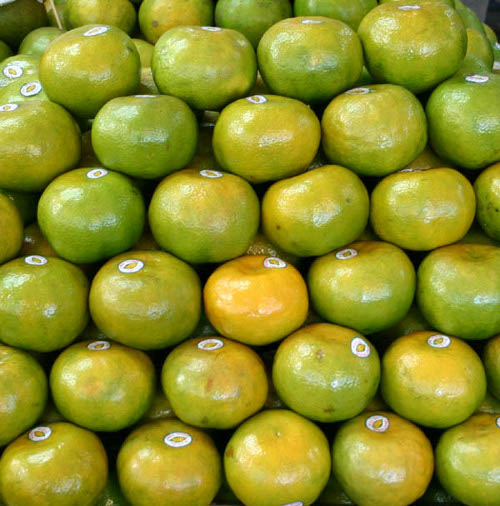One of the first tastes a new visitor gets of Thailand is the mildly sweet flavor of fresh orange juice with their morning breakfast. Thai oranges are sweet and low on acid, which makes for a smooth and sweet drink.

The most common type of Thai oranges aren’t much to look at, but their common Thai name, which translates to “sweet green orange”, pretty much says it all. The rather smooth and thin skin is typically greenish in hue with yellow blotches, or yellow-orange with green blotches, depending on how you look at it. Thais are less obsessed with the outer appearance of fruits and other foods than westerners. Oranges don’t have to have a perfectly unblemished skin, they just have to taste good.
Also easily found is a fruit with a bright lime green skin that nonetheless has orange flesh and a strong sweet orange taste. All citrus fruits originated in South-east Asia, although exactly where each strain comes from is lost in the mists of time. Citrus was already a part of traditional Chinese medicine by the first century A.D.
Perhaps even more so than in the west, Thais generally juice their oranges rather than eating the fruit directly. Thais prefer their juice fresh squeezed, rather than processed, packaged or frozen. You can find packaged juice in the supermarket, but just about everyone agrees that it doesn’t taste the same, and you won’t find frozen concentrate at all.
It is quite easy to find fresh squeezed juice stalls on the streets of most cities in Thailand, especially in the morning. The stalls will usually have a large supply of oranges on hand, with the juice squeezed by a simple hand press. The stall owner will often try to work ahead of customer demand by squeezing the oranges as fast as he can, and then filling clear plastic bottles with the result. A 500 milliliter bottle will normally cost around 50 cents.
Whole oranges are of course readily available in the fresh markets. In the Muang Mai wholesale market in Chiang Mai, whole stalls and shops sell nothing else but oranges, in an amazing variety of grades, each with its own price. Often there is no visible difference between the various grades, even though there may be as much as a 30 percent difference in price. Whole oranges are usually sold by the dozen, which will cost between 40 and 60 cents, depending on the grade.